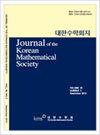A singular function from Sturmian continued fractions
IF 0.5
4区 数学
Q2 MATHEMATICS
引用次数: 1
Abstract
. For α ≥ 1, let s α ( n ) = ⌈ αn ⌉ − ⌈ α ( n − 1) ⌉ . A continued fraction C ( α ) = [0; s α (1) ,s α (2) , ... ] is considered and analyzed. Appeal- ing to Diophantine approximation, we investigate the differentiability of C ( α ), and then show its singularity.Sturmian连分式的奇异函数
. 为α≥1,让年代α(n) =⌈αn⌉−⌈α(n−1)⌉。A连分数C (α) = [0;S α (1), S α(2),…]被考虑和分析。利用丢芬图近似,研究了C (α)的可微性,并证明了它的奇异性。
本文章由计算机程序翻译,如有差异,请以英文原文为准。
求助全文
约1分钟内获得全文
求助全文
来源期刊
CiteScore
1.20
自引率
16.70%
发文量
0
审稿时长
6-12 weeks
期刊介绍:
This journal endeavors to publish significant research of broad interests in pure and applied mathematics. One volume is published each year, and each volume consists of six issues (January, March, May, July, September, November).

 求助内容:
求助内容: 应助结果提醒方式:
应助结果提醒方式:


